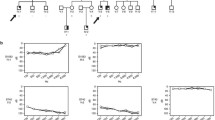Abstract
So far, subjects heterozygous for PAHX mutations are regarded as non-symptomatic. In the 24-year-old, HIV-negative daughter and the 26-year-old, HIV-negative son of a patient with Refsum disease due to the homozygous c.135-2A>G transition at the splice site before exon 3 of the PAHX gene, slight abnormalities suggestive of the disease became apparent. The daughter reported a single fever cramp in childhood, recurrent, short-lived amaurotic episodes after getting up from supine, short-sightedness, hypoacusis, and restless legs. The son complained about restless legs, hyperhidrosis, hypoacusis, and bulbar oscillations. Though both children carried the same mutation as their mother in the heterozygous form, clinical neurologic examination, nerve conduction studies and serum phytanic acid concentration were normal in both of them, implying that the described abnormalities were not causally related to the PAHX mutation. In the absence of elevated phytanic acid concentrations, clinical neurologic abnormalities in heterozygous relatives of Refsum patients are not attributable to heterozygosity for PAHX mutations.
Similar content being viewed by others
References
Jansen GA, Hogenhout EM, Ferdinandusse S et al (2000) Human phytanoyl-CoA hydroxylase: resolution of the gene structure and the molecular basis of Refsum’s disease. Hum Mol Genet 9:1195–1200
van den Brink DM, Brites P, Haasjes J et al (2003) Identification of PEX7 as the second gene involved in Refsum disease. Am J Hum Genet 72:471–477
Jansen GA, Waterham HR, Wanders RJ (2004) Molecular basis of Refsum disease: sequence variations in phytanoyl-CoA hydroxylase (PHYH) and the PTS2 receptor (PEX7). Hum Mutat 23:209–218
Wierzbicki AS, Lloyd MD, Schofield CJ et al (2002) Refsum’s disease: a peroxisomal disorder affecting phytanic acid alpha-oxidation. J Neurochem 80:727–735
Vreken P, van Lint AEM, Bootsma AH et al (1998) Rapid stable isotope dilution analysis of very-long-chain fatty acids, pristanic acid and phytanic acid using gas chromatography-electron impact mass spectrometry. J Chromatogr B 713:281–287
Dubois J, Sebag G, Argyropoulou M, Brunelle F (1991) MR findings in infantile Refsum disease: case report of two family members. Am J Neuroradiol 12:1159–1160
Chen C, Wang Q, Fang X et al (2001) Roles of phytanoyl-CoA alpha-hydroxylase in mediating the expression of human coagulation factor VIII. J Biol Chem 276:46340–46346
Koh JT, Lee ZH, Ahn KY et al (2001) Characterization of mouse brain-specific angiogenesis inhibitor 1 (BAI1) and phytanoyl-CoA alpha-hydroxylase-associated protein 1, a novel BAI1-binding protein. Mol Brain Res 87:223–237
Chambraud B, Radanyi C, Camonis JH et al (1999) Immunophilins, Refsum disease, and lupus nephritis: the peroxisomal enzyme phytanoyl-CoA alpha-hydroxylase is a new FKBP-associated protein. Proc Natl Acad Sci U S A 96:2104–2109
Jansen GA, Hogenhout EM, Ferdinandusse S et al (2000) Human phytanoyl-CoA hydroxylase: resolution of the gene structure and the molecular basis of Refsum’s disease. Hum Mol Genet 9:1195–1200
Finsterer J, Regelsberger G, Voigtländer T (2008) Refsum disease due to the splice-site mutation c. 135-2A>G before exon 3 of the PHYM gene, diagnosed eight years after detection of retinitis pigmentosa. J Neurol Sci 266:182–186
Author information
Authors and Affiliations
Corresponding author
Rights and permissions
About this article
Cite this article
Finsterer, J., Regelsberger, G. & Voigtländer, T. Non-manifesting Refsum heterozygotes carrying the c.135-2A>G PAHX gene transition. Neurol Sci 29, 173–175 (2008). https://doi.org/10.1007/s10072-008-0931-4
Received:
Accepted:
Published:
Issue Date:
DOI: https://doi.org/10.1007/s10072-008-0931-4




